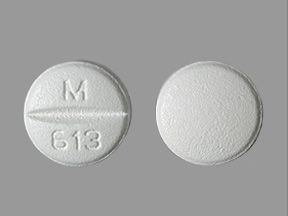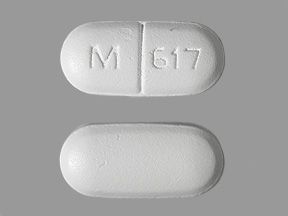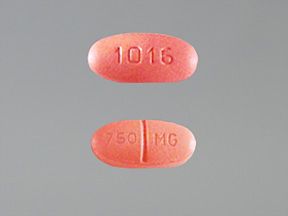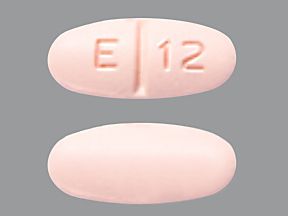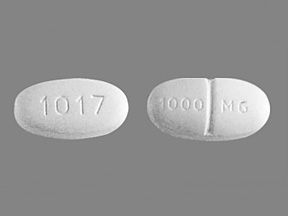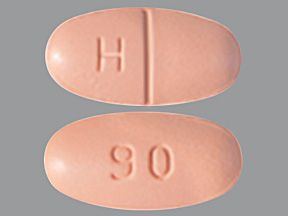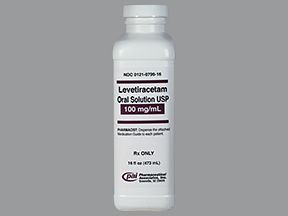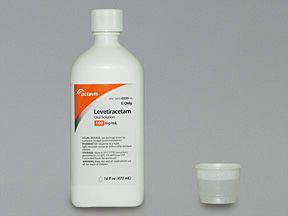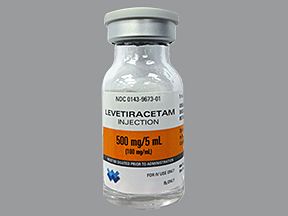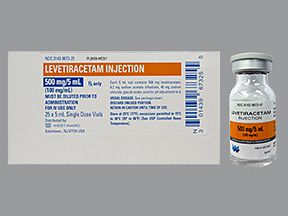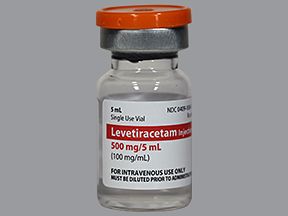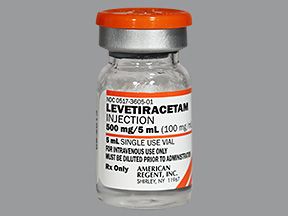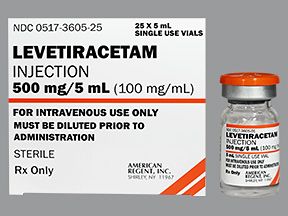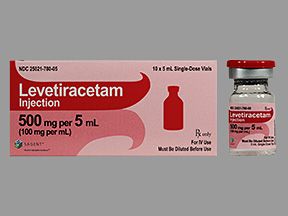Levetiracetam is a generic prescription drug. The Food and Drug Administration (FDA) has approved this medication to treat certain types of epilepsy (seizure disorders) in adults and some children, including:
- partial-onset seizures
- myoclonic seizures in people with juvenile myoclonic epilepsy*
- primary generalized tonic-clonic seizures in people with idiopathic† generalized epilepsy*
More details about these uses, including the approved age ranges in children, are described in the “Levetiracetam oral tablets uses” section below.
* For this use, levetiracetam is prescribed along with other seizure medications.
† Idiopathic means that there isn’t a known cause.
Drug details
Levetiracetam is an anti-epileptic drug (AED), also known as an anticonvulsant.
Levetiracetam comes as an oral tablet as well as an extended-release (ER) oral tablet. This drug also comes in an IV injection form and an oral solution, but this article does not cover them. Your doctor can tell you more about these forms.
Levetiracetam oral tablets are available in four strengths:
- 250 milligrams (mg)
- 500 mg
- 750 mg
- 1,000 mg
Levetiracetam ER oral tablets come in two strengths
- 500 mg
- 750 mg
Levetiracetam oral tablets are an immediate-release form of the drug. This means the tablet releases the active drug into your body at once. With levetiracetam ER oral tablets, the active drug slowly releases into your body over a period of time.
Brand-name versions
Levetiracetam is a generic drug. The brand-name version of levetiracetam oral tablets is Keppra. The brand-name version of levetiracetam ER oral tablets is Keppra XR.
Levetiracetam is a generic drug. A generic drug is an exact copy of the active drug in a brand-name medication. Keppra and Keppra XR are the brand-name medications that levetiracetam is based on. A generic is considered to be as safe and effective as the original drug. Generics tend to cost less than brand-name drugs.
If you’re interested in using Keppra or Keppra XR instead of levetiracetam, talk with your doctor. They can tell you if Keppra comes in forms and strengths that can be used for your condition. If you have insurance, you’ll also need to check whether your plan will cover Keppra or Keppra XR.
To learn more about how generics compare with brand-name drugs, see this article.
Levetiracetam can cause mild or serious side effects (also known as adverse effects). The following lists contain some of the key side effects that may occur while taking levetiracetam. These lists do not include all possible side effects.
For more information about the possible side effects of levetiracetam, talk with your doctor or pharmacist. They can give you tips on how to manage any side effects that may be concerning or bothersome.
Note: The Food and Drug Administration (FDA) tracks side effects of drugs it has approved. If you’d like to notify the FDA about a side effect you’ve had with levetiracetam, you can do so through MedWatch.
Mild side effects
Below is a partial list of mild side effects of levetiracetam. To learn about other mild side effects›, talk with your doctor or pharmacist, or view levetiracetam’s prescribing information.
Mild side effects of levetiracetam can include:
- somnolence (feeling sleepy)
- weakness
- increased risk of infection
- dizziness
- irritability
- fatigue
- nasal congestion
- not feeling as hungry as usual
- mild allergic reaction*
Most of these side effects may go away within a few days to a couple of weeks. However, if they become more severe or don’t go away, talk with your doctor or pharmacist.
* For more information about allergic reaction and levetiracetam, see “Allergic reaction” below.
Serious side effects
Serious side effects from levetiracetam aren’t common, but they can occur. Call your doctor right away if you have serious side effects. Call 911 or your local emergency number if your symptoms feel life threatening or if you think you’re having a medical emergency.
Serious side effects can include:
- behavior changes, such as aggressive behavior
- new or worsening depression, which may increase the risk of suicidal thoughts or behaviors
- severe skin reactions
- difficulties with coordination, which could lead to trouble with activities such as walking, speaking, or driving
- withdrawal seizures (more frequent or severe seizures) if levetiracetam is suddenly stopped
- severe allergic reaction*
* For details about allergic reaction and levetiracetam, see “Allergic reaction” below.
Suicide prevention
If you know someone at immediate risk of self-harm, suicide, or hurting another person:
- Ask the tough question: “Are you considering suicide?”
- Listen to the person without judgment.
- Call 911 or the local emergency number, or text TALK to 741741 to communicate with a trained crisis counselor.
- Stay with the person until professional help arrives.
- Try to remove any weapons, medications, or other potentially harmful objects.
If you or someone you know is having thoughts of suicide, a prevention hotline can help. The 988 Suicide and Crisis Lifeline is available 24 hours a day at 988. During a crisis, people who are hard of hearing can use their preferred relay service or dial 711 then 988.
Side effects in children
Most of the side effects of levetiracetam seen in adults are the same as those seen in children. However, the following side effects are more commonly seen in children than in adults:
- irritability
- fatigue
- nasal congestion
- not feeling as hungry as usual
- aggressive behavior
Talk with your child’s doctor if you have questions about the drug’s side effects.
ALLERGIC REACTIONAs with most drugs, some people can have an allergic reaction after taking levetiracetam. This side effect wasn’t reported in clinical trials of this drug but has occurred since the drug was approved.
Symptoms of a mild allergic reaction can include:
A more severe allergic reaction is rare but possible. Symptoms of a severe allergic reaction can include:
- swelling under your skin, typically in your eyelids, lips, hands, or feet
- swelling of your tongue, mouth, or throat
- trouble breathing
Call your doctor right away if you have an allergic reaction to levetiracetam, as the reaction could become severe. Call 911 or your local emergency number if your symptoms feel life threatening or if you think you’re having a medical emergency.
The Food and Drug Administration (FDA) approves prescription drugs such as levetiracetam to treat certain conditions. Doctors may also prescribe levetiracetam oral tablets off-label for other conditions. Off-label drug use is when an FDA-approved drug is prescribed for a purpose other than what it’s approved for.
FDA-approved uses of levetiracetam are described in more detail just below. To learn more about your condition, check out our hub for epilepsy and seizures.
Levetiracetam for partial-onset seizures
Levetiracetam oral tablet is FDA-approved to treat partial-onset seizures in adults and children ages 1 month and older.
Levetiracetam extended-release (ER) oral tablet is FDA-approved to treat partial-onset seizures in adults and children ages 12 years and older.
Doctors may prescribe levetiracetam oral tablets and levetiracetam ER oral tablets on their own or with other medications to treat partial-onset seizures.
Partial-onset seizures explained
Partial-onset seizures are also called focal seizures. They start on one side of the brain. During a partial-onset seizure, you may be aware of what’s happening. Or you may lose consciousness or have no memory of the seizure after it ends.
Levetiracetam and myoclonic seizures
Levetiracetam oral tablet is FDA-approved to treat myoclonic seizures in people ages 12 years and older who have juvenile myoclonic epilepsy. (Juvenile myoclonic epilepsy is a type of seizure that starts during puberty or young adulthood.) For this use, doctors prescribe levetiracetam along with other seizure medications. Examples include valproic acid and lamotrigine (Lamictal, Lamictal XR, others).
Levetiracetam ER oral tablet is not FDA-approved for this use.
Myoclonic seizures explained
With myoclonic seizures, you have muscle jerks and twitches. These seizures affect both sides of your brain, causing sudden but brief movements. You’ll remain awake and aware during this type of seizure.
Levetiracetam and generalized tonic-clonic seizures
Levetiracetam oral tablet is FDA-approved to treat primary generalized tonic-clonic seizures in adults and children ages 6 years and older who have idiopathic generalized epilepsy. (Idiopathic means that there isn’t a known cause.) For this use, levetiracetam is prescribed along with other seizure medications. Examples include valproic acid and lamotrigine (Lamictal, Lamictal XR, others).
Levetiracetam ER oral tablet is not FDA-approved for this use.
Generalized tonic-clonic seizures explained
Generalized tonic-clonic seizures involve both sides of the brain. In some cases, partial-onset seizures turn into generalized seizures.
“Tonic” refers to sudden muscle stiffness that happens during some seizures, and “clonic” describes repeated jolting movements that can occur. With a generalized tonic-clonic seizure, you’ll lose consciousness. And you probably won’t remember the seizure after it ends.
Levetiracetam and children
Levetiracetam oral tablet is FDA-approved to treat the following conditions in children:
- partial-onset seizures in children ages 1 month and older
- myoclonic seizures in children ages 12 years and older who have juvenile myoclonic epilepsy (a type of seizure disorder)*
- primary generalized tonic-clonic seizures in children ages 6 years and older who have idiopathic† generalized epilepsy*
Levetiracetam ER oral tablet is FDA-approved to treat partial-onset seizures in children ages 12 years and older.
* For this use, doctors prescribe levetiracetam along with other seizure medications, such as valproic acid and lamotrigine (Lamictal, Lamictal XR, others).
† Idiopathic means that there isn’t a known cause.
Here are answers to some frequently asked questions about levetiracetam.
Does levetiracetam 500 mg cause weight gain?
It shouldn’t. Weight gain wasn’t reported as a side effect in people who took levetiracetam in clinical trials of levetiracetam oral tablet or levetiracetam extended-release oral tablet. However, after the drug became available for use, weight loss has been reported as a possible side effect.
Talk with your doctor if you experience weight changes that concern you during levetiracetam treatment. They can recommend ways to help you maintain a weight that’s healthy for you.
Can levetiracetam be used for dogs?
Possibly. Veterinarians sometimes prescribe human drugs for use in animals.
Talk with your pet’s veterinarian for more information about levetiracetam or other medications.
Will I start with a loading dose of levetiracetam?
No. Levetiracetam treatment is not typically started with a loading dose. (A loading dose refers to a high dose of a drug that’s given when you begin treatment. It can help certain drugs start to work quickly.)
Instead, you’ll likely start with a low or moderate dosage of levetiracetam. Then your doctor may increase your dosage every 2 weeks until they find the amount that works for managing your seizures. For details about dosage, see the “Levetiracetam oral tablets dosage” section below.
Your doctor will determine the starting dosage that fits your needs.
Is levetiracetam a controlled substance?
No, levetiracetam is not a controlled substance. (Controlled substances are drugs or chemicals that may cause drug dependence or lead to misuse.)
Levetiracetam belongs to a class of drugs known as anti-epileptic drugs (AEDs). Some other drugs in this class are controlled substances, but levetiracetam is not one of them. Examples of AEDs that are controlled substances include perampanel (Fycompa) and brivaracetam (Briviact).
Does levetiracetam cause certain side effects in older adults?
In clinical trials of levetiracetam oral tablet or levetiracetam extended-release oral tablet, older adults experienced the same side effects as those seen in younger adults. (In these trials, “older adults” refers to adults ages 65 years and older.)
However, older adults may be more vulnerable to some of levetiracetam’s side effects. For example, the drug may cause difficulty with coordination, such as feeling off-balance while walking. In an older adult, this side effect may be more likely to cause falls and subsequent fractures or other related injuries.
If you’re an older adult, talk with your doctor about what to expect during treatment with levetiracetam.
How does levetiracetam compare with lamotrigine or brivaracetam?
Levetiracetam, lamotrigine (Lamictal, Lamictal XR, others), and brivaracetam (Briviact) are all prescription drugs. They’re FDA-approved to treat certain types of seizure disorders in adults and some children.
Specifically, lamotrigine and brivaracetam can be used to treat partial-onset seizures. Doctors also prescribe lamotrigine to treat the following seizure types:
- primary generalized tonic-clonic seizures
- seizures that occur with Lennox-Gastaut syndrome (a type of severe epilepsy)
In addition, lamotrigine can be used to treat bipolar I disorder.
To learn about levetiracetam’s uses, see the “Levetiracetam oral tablets uses” section above.
These drugs vary in their forms and possible side effects. Your doctor or pharmacist can help determine which medications may be right for you.
The levetiracetam dosage your doctor prescribes will depend on several factors. These include the:
- type and severity of the condition you’re using levetiracetam to treat
- person’s age and weight (in children)
- type of levetiracetam tablet you take
- other medical conditions you may have
Typically, your doctor will start you on a low dosage. Then they’ll adjust it over time to reach the amount that’s right for you. Your doctor will ultimately prescribe the smallest dosage that provides the desired effect.
The following information describes dosages that are commonly used or recommended. However, be sure to take the dosage your doctor prescribes for you. Your doctor will determine the best dosage to fit your needs.
Dosage for partial-onset seizures
Here’s levetiracetam dosage information for partial-onset seizures. The strength of the medication is measured in milligrams (mg).
| Levetiracetam for partial-onset seizures | |
| Forms | • oral tablet • extended-release (ER) oral tablet |
| Strengths | oral tablets: • 250 mg • 500 mg • 750 mg • 1,000 mg extended-release (ER) oral tablets: • 500 mg • 750 mg |
| Dose | 500 mg or 1,000 mg to start; dose may be increased every 2 weeks to a maximum dose of 3,000 mg |
| How often | • oral tablets: twice per day • ER oral tablets: once per day |
| Administered by | self |
This drug may require renal dosing, which is an adjusted or low dosage typically used in people with renal (kidney) problems. Talk with your doctor for details about renal dosage adjustments.
Dosage for myoclonic seizures
Here’s levetiracetam dosage information for myoclonic seizures.
| Levetiracetam for myoclonic seizures | |
| Forms | oral tablet* |
| Strengths | • 250 mg • 500 mg • 750 mg • 1,000 mg |
| Dose | 500 mg to start; dose may be increased every 2 weeks to the recommended dose of 1,500 mg |
| How often | twice per day |
| Administered by | self |
This drug may require renal dosing, which is an adjusted or low dosage typically used in people with renal (kidney) problems. Talk with your doctor for details about renal dosage adjustments.
* Levetiracetam ER oral tablet is not FDA-approved for this use.
Dosage for generalized tonic-clonic seizures
Here’s levetiracetam dosage information for generalized tonic-clonic seizures.
| Levetiracetam for generalized tonic-clonic seizures | |
| Forms | oral tablet* |
| Strengths | • 250 mg • 500 mg • 750 mg • 1,000 mg |
| Dose | 500 mg to start; dose may be increased every 2 weeks to reach the recommended dose of 1,500 mg |
| How often | twice per day |
| Administered by | self |
This drug may require renal dosing, which is an adjusted or low dosage typically used in people with renal (kidney) problems. Talk with your doctor for details about renal dosage adjustments.
* Levetiracetam ER oral tablet is not FDA-approved for this use.
Children’s dosage
Levetiracetam is approved to treat the following types of seizures in certain children.
Dosage for partial-onset seizures in children
For partial-onset seizures, the dosage of levetiracetam oral tablets in children ages 1 month and older will depend on the child’s age and body weight in kilograms (kg). One kg equals about 2.2 pounds (lb).
Your child’s doctor will likely prescribe a low dose to start. Then they may increase the dose every 2 weeks until they reach the recommended dose.
The table below summarizes the children’s dosage of levetiracetam oral tablet for partial-onset seizures in children.
| Age | Starting dose | Recommended dose | How often |
| 1 month to less than 6 months | 7 mg/kg | 21 mg/kg | twice per day |
| 6 months to less than 4 years | 10 mg/kg | 25 mg/kg | twice per day |
| 4 years to less than 16 years | 10 mg/kg | 30 mg/kg | twice per day |
| 16 years and older | 500 mg | 1,500 mg | twice per day |
Levetiracetam ER oral tablet is FDA-approved to treat partial-onset seizures in children ages 12 years and older. For people in this age group who weigh 50 kg or more, the typical dosage is the same as the adult dosage for this use. For details, see the “Dosage for partial-onset seizures” section above.
Dosage for myoclonic seizures in children
Levetiracetam oral tablet is FDA-approved to treat myoclonic seizures in children ages 12 years and older who have juvenile myoclonic epilepsy (a type of seizure disorder). For this use, the typical dosage is the same as the adult dosage. For details, see the “Dosage for myoclonic seizures” section above.
Levetiracetam ER oral tablet is not FDA-approved for this use.
Dosage for generalized tonic-clonic seizures in children
Levetiracetam oral tablet is FDA-approved to treat primary generalized tonic-clonic seizures in children ages 6 years and older who have idiopathic generalized epilepsy. (Idiopathic means that there isn’t a known cause.)
For this use, the typical dosage for children ages 6 years to less than 16 years is 10 mg/kg twice per day to start. Then the dose may be increased every 2 weeks to the recommended dosage of 30 mg/kg twice per day.
For children ages 16 years and older, the dosage is the same as the adult dosage for this use. For details, see the “Dosage for generalized tonic-clonic seizures” section above.
Levetiracetam ER oral tablet is not FDA-approved for this use.
What if I miss a dose?
If you miss a dose of levetiracetam and it has only been a few hours since the time you were supposed to take it, you’ll take the missed dose now. But, if it’s nearly time for your next dose, you’ll skip the missed dose. You’ll then continue with your regular dosing schedule. Do not double your dose to make up for a missed one.
To help make sure that you don’t miss a dose, try using a medication reminder. This can include setting an alarm or using a timer. You could also download a reminder app on your phone.
Will I need to use this drug long term?
Levetiracetam is meant to be a long-term treatment. If you and your doctor determine that levetiracetam is safe and effective for you, you’ll likely take it long-term.
Levetiracetam is not known to interact with other medications, herbs, supplements, or foods. The manufacturer of levetiracetam didn’t find any drug interactions in studies of the drug.
However, this doesn’t mean that interactions won’t be recognized in the future. For example, new drugs could be approved that interact with levetiracetam.
Before starting treatment with levetiracetam, talk with your doctor and pharmacist. Tell them about all prescription, over-the-counter, and other drugs you take. Also, tell them about any vitamins, herbs, and supplements you take. Sharing this information can help you avoid potential interactions.
If you have questions about drug interactions that may affect you, talk with your doctor or pharmacist.
Alcohol isn’t known to interact with levetiracetam. However, alcohol and levetiracetam may cause some of the same side effects, such as feeling sleepy, dizziness, or difficulty with coordination. So, mixing the two may increase the risk or severity of these side effects.
If you drink alcohol, talk with your doctor about how much, if any, is safe for you to drink during treatment with levetiracetam.
This section describes what’s known about the safety of levetiracetam while pregnant or breastfeeding.
Levetiracetam and pregnancy
It’s not known whether levetiracetam is safe to take during pregnancy. This is because human studies haven’t looked at the drug’s effects during pregnancy. In studies of pregnant animals, levetiracetam caused harmful effects in fetuses. However, animal studies don’t necessarily reflect what will happen in humans.
If you’re pregnant or planning to become pregnant, talk with your doctor. They can suggest safe treatment options for you.
Note that if your doctor prescribes levetiracetam for you while you’re pregnant, they may need to increase your dosage. This is because the drug’s level in the body tends to decrease during pregnancy, especially in the third trimester. Your doctor will also monitor you more closely than usual to make sure your seizure disorder is well-managed during pregnancy.
Pregnancy registry
People who take levetiracetam or other anti-epileptic drugs (AEDs) during pregnancy are encouraged to sign up for the North American Antiepileptic Drug (NAAED) Pregnancy Registry. Pregnancy registries help healthcare professionals collect information about the safety of certain drugs. This can help people make informed decisions about the medications they take during pregnancy. You can learn more about the NAAED Pregnancy Registry online or by calling 888-233-2334.
Levetiracetam and fertility
Levetiracetam isn’t known to affect a person’s fertility (ability to get pregnant). No negative effects on fertility were seen in studies when animals were exposed to the drug.
Levetiracetam and breastfeeding
It is not known whether levetiracetam is safe to take while breastfeeding.
The drug passes into breast milk. Human studies haven’t looked at the drug’s effects in a breastfed child. In studies of lactating animals, levetiracetam did not cause harmful effects in offspring. However, animal studies don’t necessarily reflect what will happen in humans.
If you’re breastfeeding or planning to breastfeed, talk with your doctor. They can suggest safe treatment options for you during this time.
Levetiracetam and birth control
It’s not known if levetiracetam is safe to take during pregnancy. If you’re sexually active and you or your partner can become pregnant, talk with your doctor about your birth control needs while you’re using levetiracetam.
For more information about taking levetiracetam during pregnancy, see the “Levetiracetam and pregnancy” section above.
As with all medications, the cost of levetiracetam can vary. The actual price you’ll pay depends on your insurance plan, your location, and the pharmacy you use.
Keep in mind that you may be able to get a 90-day supply of levetiracetam. If approved by your insurance company, getting a 90-day supply of the drug could reduce your number of trips to the pharmacy and help lower the cost. If you’re interested in this option, check with your doctor, pharmacist, or insurance company.
Before approving coverage for levetiracetam, your insurance company may require you to get prior authorization. This means that your doctor and insurance company will need to communicate about your prescription before the insurance company will cover the drug. The insurance company will review the prior authorization request and decide whether the drug will be covered.
If you’re not sure whether you’ll need to get prior authorization for levetiracetam, contact your insurance company.
Financial and insurance assistance
Financial assistance to help you pay for levetiracetam may be available.
Medicine Assistance Tool and NeedyMeds are two websites offering resources that may help decrease the price you pay for levetiracetam. They also offer tools to help you find low cost healthcare, as well as educational resources. To learn more, visit their sites.
Mail-order pharmacies
Levetiracetam may be available through a mail-order pharmacy. Using this service may help lower the drug’s cost and allow you to get your medication without leaving home.
If recommended by your doctor, you may be able to receive a 90-day supply of levetiracetam, so there’s less concern about running out of the medication. If you’re interested in this option, check with your doctor, pharmacist, or insurance company. Some Medicare plans may help cover the cost of mail-order medications.
If you don’t have insurance, you can ask your doctor or pharmacist about online pharmacy options.
This drug comes with several precautions. These are considered drug-condition interactions.
If any of the following medical conditions or other health factors pertain to you, be sure to talk with your doctor before taking levetiracetam.
- You’re pregnant or thinking about becoming pregnant.
- You’re breastfeeding or thinking about breastfeeding.
- You’ve had an allergic reaction to either drug or any of its ingredients.
- You have a history of mental health conditions, such as depression, or suicidal thoughts.
- You have kidney problems, such as kidney failure.
Note: For more information about the potential negative effects of levetiracetam, see the “Levetiracetam oral tablets side effects” section above.
Take levetiracetam according to the instructions your doctor gives you.
You’ll take levetiracetam tablets by mouth. The drug may be taken with or without food.
When to take
Levetiracetam extended-release (ER) oral tablets are typically taken once per day. Levetiracetam oral tablets are usually taken twice per day, or every 12 hours.
Taking the medication consistently helps keep a steady level of the drug in your body. This helps levetiracetam work effectively to treat your seizure disorder.
To help make sure that you don’t miss a dose, try using a medication reminder. This can include setting an alarm or using a timer. You could also download a reminder app on your phone.
Accessible labels and containers
If your prescription label is hard to read, talk with your doctor or pharmacist. Some pharmacies offer labels that have large print, braille, or a code you scan with a smartphone to convert text to speech. If your local pharmacy doesn’t have these options, your doctor or pharmacist may be able to direct you to one that does.
If you have trouble opening medication bottles, ask your pharmacist if they can put levetiracetam in an easy-open container. They also may be able to recommend tools that can make it simpler to open lids.
Taking levetiracetam with food
The drug may be taken with or without food.
Can levetiracetam be crushed, split, or chewed?
No. Do not crush, split, or chew levetiracetam oral tablets. This includes both the oral tablets and the ER oral tablets.
Do not take more levetiracetam than your doctor recommends. For some drugs, doing so may lead to unwanted side effects or overdose.
What to do in case you take too much levetiracetam
If you think you’ve taken too much of this drug, call your doctor. You can also call America’s Poison Centers at 800-222-1222 or use its online tool. However, if your symptoms are severe, call 911 or your local emergency number, or go to the nearest emergency room right away.
When you get levetiracetam from the pharmacy, the pharmacist will add an expiration date to the label on the bottle. This date is typically 1 year from the date they dispensed the medication.
The expiration date helps guarantee that the medication is effective during this time. The
Storage
How long a medication remains good can depend on many factors, including how and where you store the medication.
Levetiracetam should be stored at room temperature of 68°F to 77°F (20°C to 25°C). You can temporarily store the drug at temperatures of 59°F to 86°F (15°C to 30°C), such as while traveling. Be sure to keep levetiracetam tablets in a tightly sealed container. Avoid storing this medication in areas where it could get damp or wet, such as bathrooms.
Disposal
If you no longer need to take levetiracetam and have leftover medication, it’s important to dispose of it safely. This helps prevent others, including children and pets, from taking the drug by accident. It also helps keep the drug from harming the environment.
This article provides several useful tips on medication disposal. You can also ask your pharmacist for information about how to dispose of your medication.
Disclaimer: Medical News Today has made every effort to make certain that all information is factually correct, comprehensive, and up to date. However, this article should not be used as a substitute for the knowledge and expertise of a licensed healthcare professional. You should always consult your doctor or another healthcare professional before taking any medication. The drug information contained herein is subject to change and is not intended to cover all possible uses, directions, precautions, warnings, drug interactions, allergic reactions, or adverse effects. The absence of warnings or other information for a given drug does not indicate that the drug or drug combination is safe, effective, or appropriate for all patients or all specific uses.

